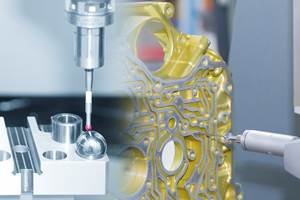Do's And Don'ts For Keeping Dial Indicators In The Game
Just because dial indicators have been around since the early 1900s, don't expect them to fade away with the last century. This tool's long-term popularity is well earned.
Share






Just because dial indicators have been around since the early 1900s, don't expect them to fade away with the last century. This tool's long-term popularity is well earned. Dial indicators offer good resolution at low cost, but that is not the main reason people still use them.
Beyond providing easy-to-read quantitative measurement, dial indicators give users a comparative sense that their parts are in the ballpark. The user simply notes if the indicator's needle is within tolerance bands or, simpler still, if the needle lies within red sections highlighted on the dial. No interpreting is necessary.
Dial indicators vary widely in type, size and range. All translate variations (through internal movement of a plunger) into dial readings. Some will indicate dimensional variations as small as 0.00005", so you must handle these sensitive mechanisms with the same devoted care you use with other precision equipment.
To maintain high levels of quality and precision, take heed of the following tips.
DO:
- mount dial indicators close to short support columns on test sets or comparators to avoid holding rod deflection.
- keep the reference surface clean and level, with the test set base clean and seated positively.
- mount your indicator securely to the fixture or holding device.
- keep the indicator spindle and point clean, using a soft, lint-free cloth.
- make sure the indicator hand moves toward the minus side of the dial as workpiece dimension decreases.
- handle the gage lightly, so it can seat itself on the workpiece.
- use diamond, tungsten carbide or hard chromium-tipped indicator points whenever it's likely that the contacts will be subject to heavy wear.
- store dial indicators in a safe, dry place, and cover them to keep the dust and moisture out.
- test indicators under gaging conditions at intervals during the operating day. You can gage a part twice, then compare its readings to a master part.
- clean dials with soap and water, benzene or soft eraser. Frequency of cleaning depends on the type of gaging and the contaminants.
DO NOT:
- subject indicators to harsh, sudden blows. If blows are unavoidable, use a cushioned movement indicator.
- overlook accessories that will make your indicator more efficient, more adaptable and more versatile, such as lifting levers and right angle attachments.
- oil the spindle bearings except under special conditions. Then do it sparingly and never use grease.
- tighten contact points or adapters too far against the rack spindle, as the strain will cause distortion and make the spindle bind and the mechanism stick.
- clamp the indicator against the stem with a set screw. Too much pressure will make the rack spindle bind.
- lock the indicator in position until you've set it carefully under proper gaging tension, that is, at least a quarter turn from its “at rest” position.
- oil an indicator that has been idle for some time. If the spindle sticks, work it in and out by hand until it slides freely on its own bearings.
- drill holes in the back of the case. Chips will get inside and ruin the movement.
- use an indicator that has been dropped or struck until you have it tested thoroughly.
- use your dial indicator for anything but what it is intended for—accurate gaging. It's not a jackhammer or paperweight.
Related Content
Rethink Quality Control to Increase Productivity, Decrease Scrap
Verifying parts is essential to documenting quality, and there are a few best practices that can make the quality control process more efficient.
Read MoreProcess Control — Leveraging Machine Shop Connectivity in Real Time
Renishaw Central, the company’s new end-to-end process control software, offers a new methodology for producing families of parts through actionable data.
Read MoreParts and Programs: Setup for Success
Tips for program and work setups that can simplify adjustments and troubleshooting.
Read MoreMeasuring Torque, Thrust Force for Smart Drilling Operations
To monitor drilling operations for smart manufacturing solutions, torque and thrust force can be measured.
Read MoreRead Next
AMRs Are Moving Into Manufacturing: 4 Considerations for Implementation
AMRs can provide a flexible, easy-to-use automation platform so long as manufacturers choose a suitable task and prepare their facilities.
Read MoreMachine Shop MBA
Making Chips and 91ÊÓƵÍøÕ¾ÎÛ are teaming up for a new podcast series called Machine Shop MBA—designed to help manufacturers measure their success against the industry’s best. Through the lens of the Top Shops benchmarking program, the series explores the KPIs that set high-performing shops apart, from machine utilization and first-pass yield to employee engagement and revenue per employee.
Read MoreLast Chance! 2025 Top Shops Benchmarking Survey Still Open Through April 30
Don’t miss out! 91ÊÓƵÍøÕ¾ÎÛ's Top Shops Benchmarking Survey is still open — but not for long. This is your last chance to a receive free, customized benchmarking report that includes actionable feedback across several shopfloor and business metrics.
Read More



















